A Leader’s Responsibility & The True Cost of Employee Turnover
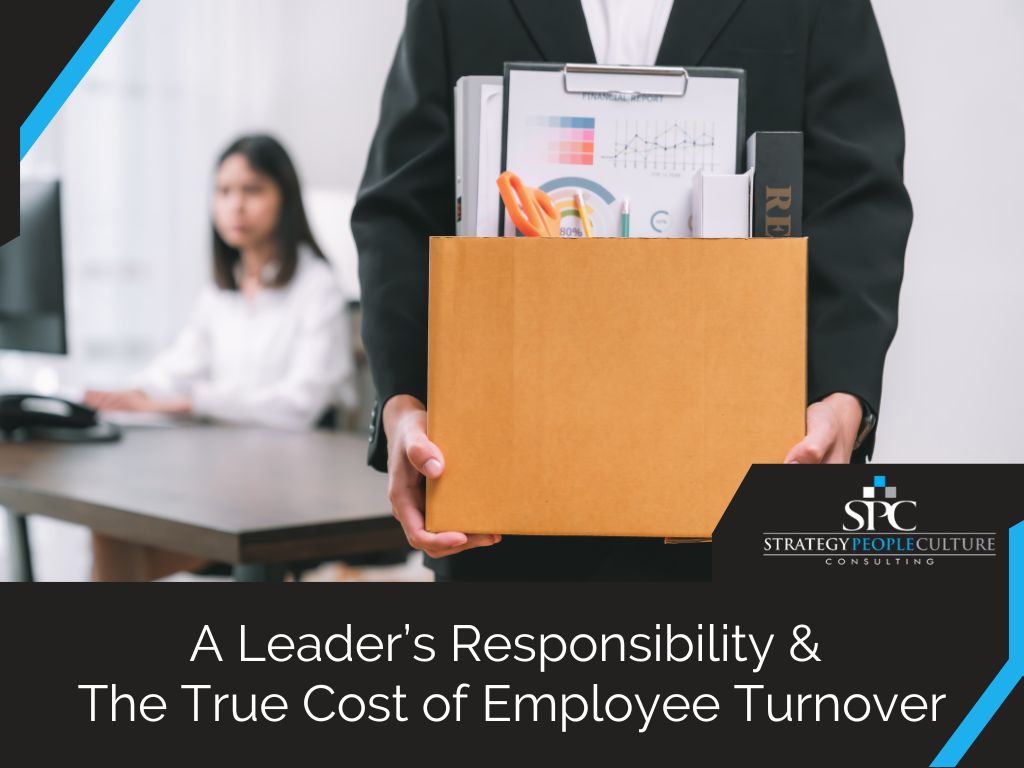
Employee turnover is more than just a metric on an HR report—it’s a tangible cost that impacts the financial health, culture, and overall success of an organization. Despite its significance, many companies continue to underestimate its consequences, often focusing on short-term solutions that fail to address the root causes. In this article, we’ll explore why ignoring employee turnover can be a costly mistake and how leadership development can be a game-changer in retaining top talent.
Why You Shouldn’t Ignore Employee Turnover
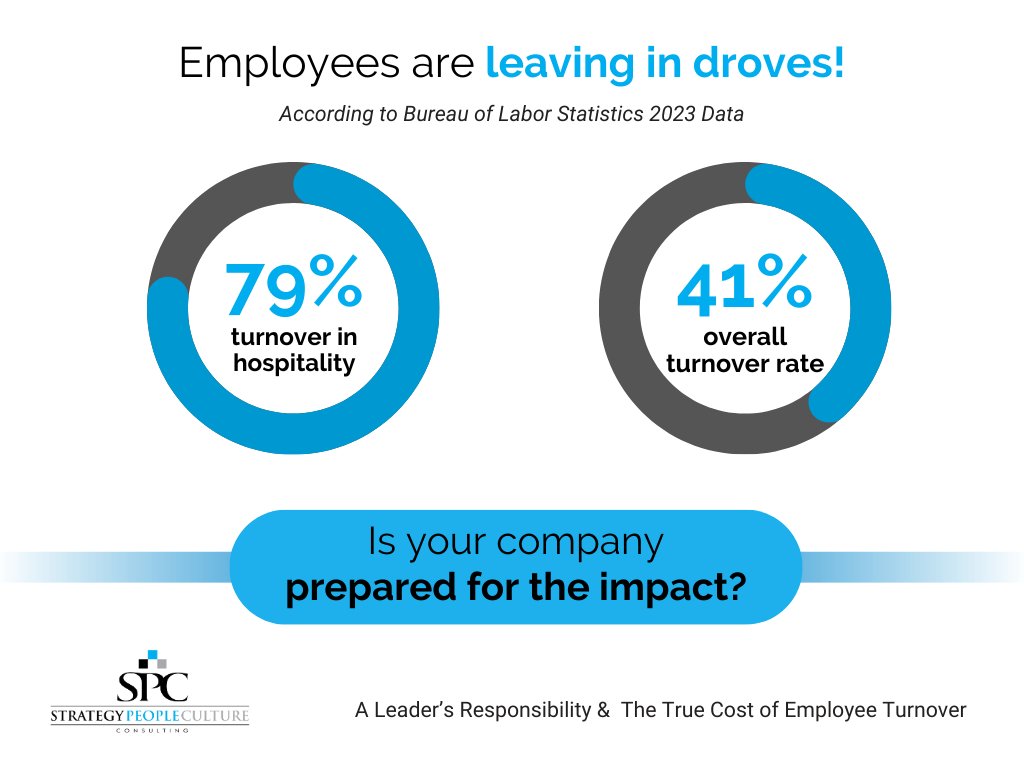
Employee turnover is becoming an increasingly pressing issue for businesses across industries. According to the Bureau of Labor Statistics data, the overall turnover rate for U.S. companies was 41% in 2023, with some industries like hospitality experiencing rates as high as 79%. This trend highlights the urgent need for organizations to understand both the financial and psychological costs of turnover and implement strategies to mitigate them.
Breaking Down the Costs of Turnover
Financial Costs of Losing Employees
The direct financial implications of losing employees are significant. The Society for Human Resource Management (SHRM) estimates that the average cost per hire is around $4,700, with a time to fill a position of approximately 42 days. However, these numbers only scratch the surface.
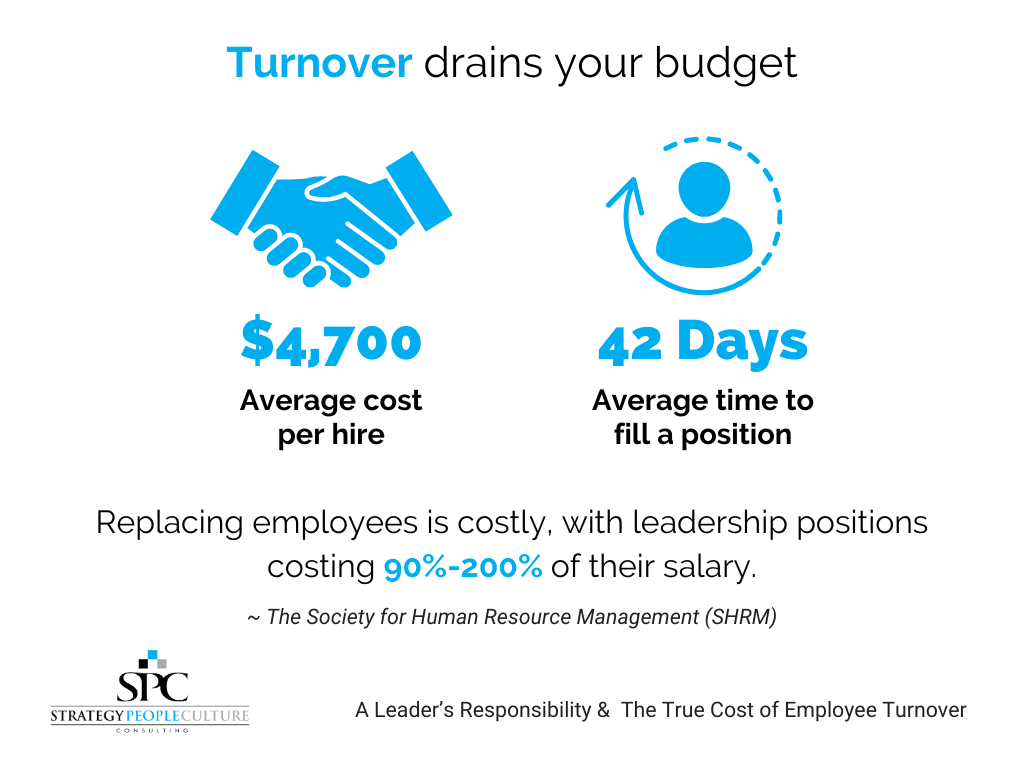
- Recruitment and Training Costs: Hiring and training new employees involve expenses that go beyond advertising the vacancy and conducting interviews. The costs of onboarding, training, and lost productivity during the learning curve can add up quickly. If your organization pays outside recruiters, the costs go up significantly.
- Loss of Productivity: The gap left by a departing employee can lead to decreased team productivity. It takes time for new hires to become fully productive, and during this period, projects may be delayed and team dynamics disrupted.
- Hidden Costs: Beyond the obvious financial impact, turnover can lead to decreased morale, increased workload for remaining employees, and potential delays in project timelines. These factors collectively disrupt team cohesion and business performance. Some of the institutional knowledge that gets lost by some turnover may have hidden consequences long into the future.
Impact on Company Culture
Turnover doesn’t just drain financial resources; it can also erode the emotional and cultural fabric of an organization.
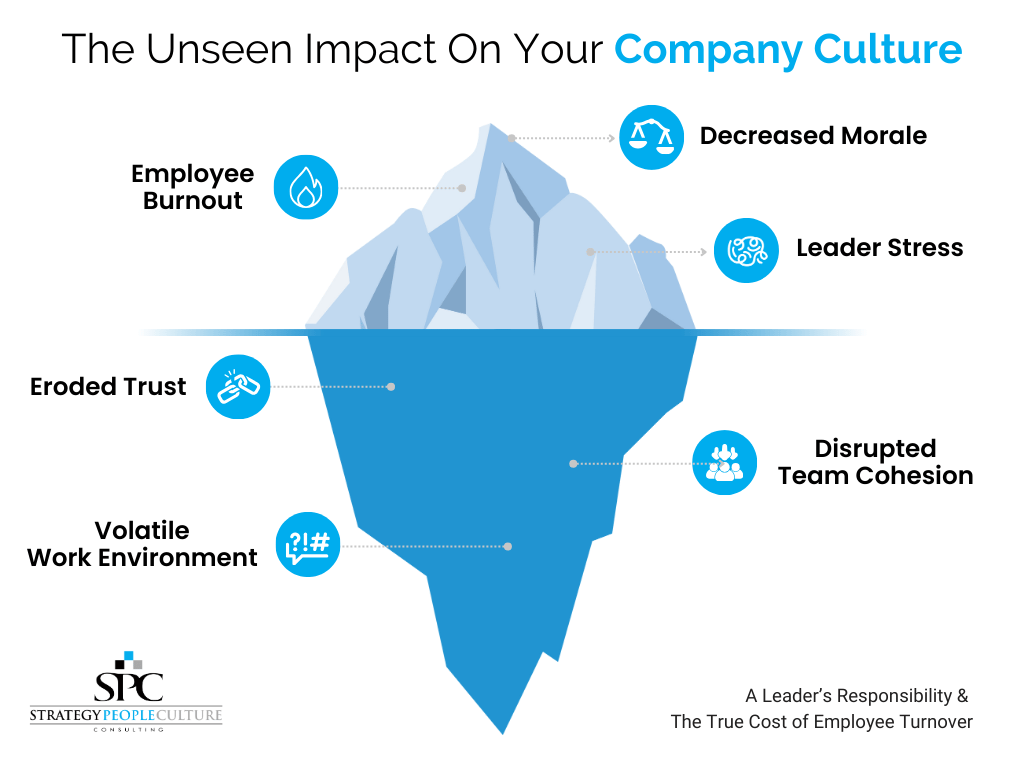
- Emotional Impact of Losing Employees: Frequent turnover can destabilize teams, erode trust, and create a volatile work environment. When employees see colleagues leave regularly, it can shake their confidence in the company’s stability and leadership.
- Employee Burnout: Remaining employees often bear the burden of additional work when a team member leaves, leading to increased stress and burnout. This cycle can contribute to even more turnover, creating a vicious loop.
- Leader Stress: For leaders, turnover means repeatedly going through the hiring and training process, which can lead to frustration and stress. This constant cycle can distract leaders from strategic initiatives and long-term planning.
Root Causes of Employee Turnover
Understanding the root causes of turnover is crucial for addressing the issue effectively. Here are some of the most common factors:
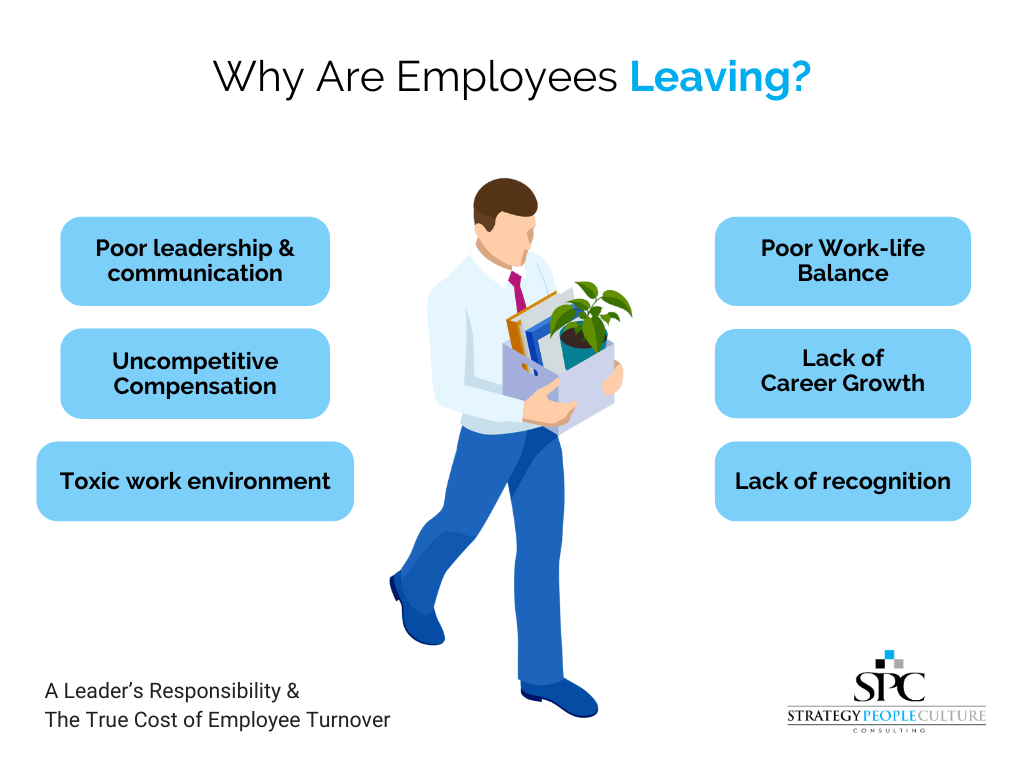
- Poor Leadership and Communication: Ineffective leadership and lack of communication are major contributors to disengagement. Leaders who fail to provide feedback, guidance, and recognition can inadvertently push employees away. The adage “people leave managers, not companies” is not absolute; however, it has real merit.
- Lack of Career Growth Opportunities: Employees who don’t see a clear path to advancement are more likely to seek opportunities elsewhere. Companies need to invest in career development plans and provide opportunities for skill enhancement. According to the e-learning provider imc Learning’s 2022 Workplace Learning Report, 92% of employees say access to professional development opportunities is a key factor in deciding to stay with their employer. Even in situations where there is not an upward trajectory for some job roles, employers find that as an excuse not to invest in the growth of their people, ultimately contributing to turnover.
- Inadequate Work-Life Balance: The demand for flexible work arrangements has increased, especially post-pandemic. Companies that fail to adapt to these changes risk losing talent to more flexible competitors.
- Uncompetitive Compensation and Benefits: Competitive salaries and benefits are essential for retaining top talent. Organizations need to review their compensation packages to ensure they remain attractive regularly.
- Toxic Work Environment: A toxic culture can drive employees away faster than any other factor. Addressing workplace issues such as bullying, discrimination, or lack of support is critical for retention.
- Lack of Recognition and Appreciation: People (in business, we call them “employees” have a basic need to feel valued and appreciated. A culture that regularly recognizes achievements and contributions fosters loyalty and commitment.
- Unclear Job Expectations or Role Misalignment: Misalignment between job expectations and the reality of the role can lead to frustration and dissatisfaction. Ensuring employees are well-matched to their roles is crucial.
- High Workload and Burnout: Excessive workloads can lead to burnout, causing employees to seek relief through resignation. Maintaining a healthy work-life balance is essential to retention.
- Poor Onboarding Process: An inadequate onboarding experience can set the stage for early turnover. When employees do not feel they belong, often that will lead to discontent and a desire to find a place to work where they feel more comfortable. Companies must ensure new hires are integrated effectively and supported from day one.
The Role of Leadership in Reducing Turnover
Leadership plays a pivotal role in employee retention. Good leadership can inspire and motivate employees, while poor leadership can drive them out the door. Executive coaching is a powerful tool that can transform leadership effectiveness and, consequently, retention rates.
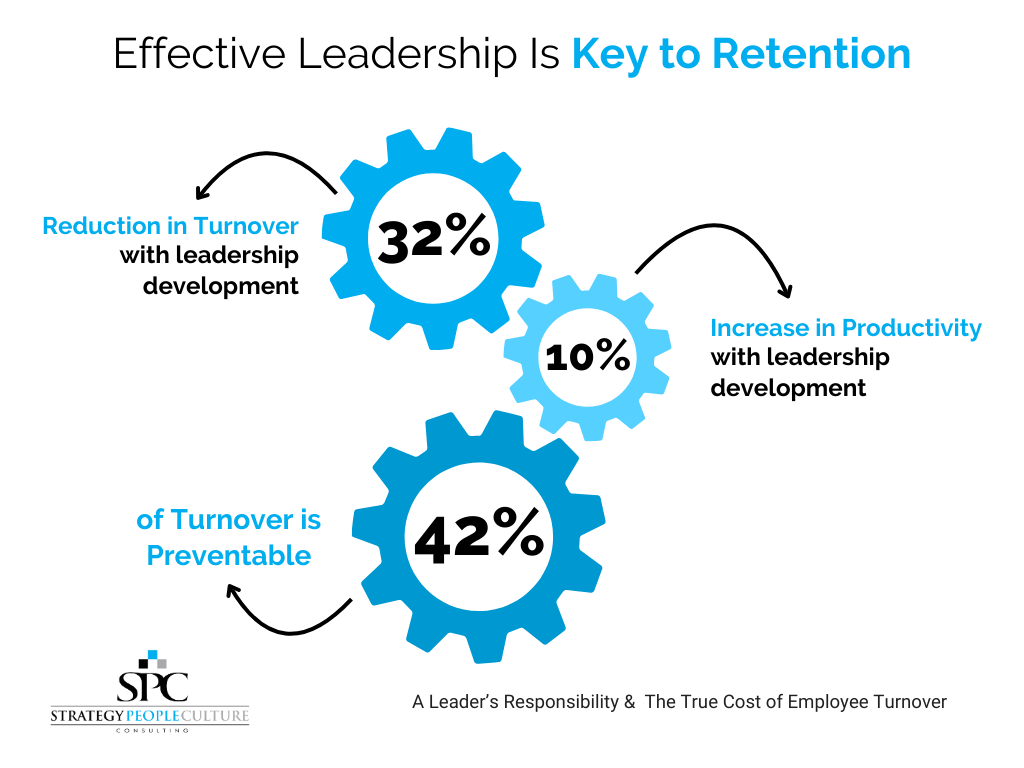
How Leadership Coaching Improves Retention Rates
Leadership coaching helps leaders develop skills in communication, conflict resolution, and strategic thinking. By fostering a culture of accountability and support, leaders can create an environment where employees feel valued and understood.
Case Studies: Companies that Reduced Turnover Through Executive Coaching
Companies that have invested in leadership development report significant reductions in turnover. See examples below:
Mutual of Omaha: This Fortune 500 insurance company faced high turnover rates in technology roles. To address this, they implemented a series of employee surveys, including engagement and pulse surveys, to better understand employee perceptions. They found that clearer communication about post-pandemic work arrangements and a focused effort on career development were key to retention. As a result, they achieved a 94% favorability rating from new hires and an 86% overall retention rate.
Credit Suisse: The financial services giant used predictive people analytics to identify employees most likely to leave based on factors such as performance ratings and team size. This data-driven approach enabled them to proactively address risk factors, ultimately reducing turnover and its associated costs. By targeting specific predictors of turnover, they were able to implement preemptive measures that significantly improved retention.
Psychological Impacts of Good vs. Bad Leadership
Good leadership can significantly improve employee morale, engagement, and retention. Conversely, poor leadership is a leading cause of employee dissatisfaction and turnover. According to Gallup, 42% of employee turnover is preventable, but many organizations fail to take action. The study found that most employees who left their jobs did not feel engaged by their managers or discuss their dissatisfaction before deciding to leave.
Proactive management, regular conversations about career growth, and addressing workplace issues could significantly reduce turnover. SHRM also suggests replacing employees is costly, with leadership positions costing 90%-200% of their salary. These findings emphasize the need for better communication and engagement strategies to retain talent.
Data-Driven Solutions to Reduce Employee Turnover
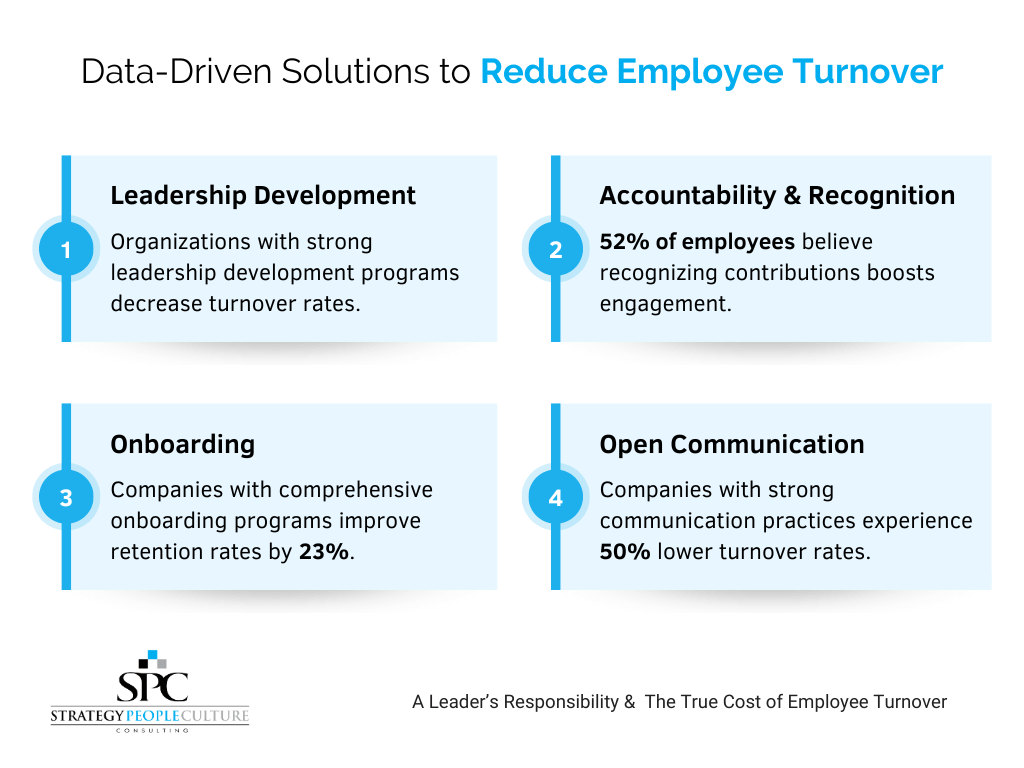
- Invest in Leadership Development
Companies that invest in leadership development experience a 32% reduction in turnover rates and a 10% increase in productivity, according to the International Coach Federation. Organizations with strong leadership development programs decrease turnover rates more than those without such programs.
- Create a Culture of Accountability and Recognition
Building a culture where employees feel valued and accountable is essential. Regular recognition and a focus on achievements can boost morale and commitment. According to recent data, 52% of employees believe that recognizing their contributions can boost engagement levels, making them more likely to stay with the company. Moreover, organizations that prioritize employee recognition see 31% lower voluntary turnover rates and a significant boost in morale and productivity.
- Implement a Clear Onboarding Process
A well-structured onboarding process is crucial for retention. Companies with comprehensive onboarding programs improve retention rates by 23%. Nearly one-quarter of employees state they are more likely to stay with an organization that clearly defines job responsibilities from the outset. Despite the clear link between effective onboarding and retention, 76% of HR leaders feel their onboarding processes are not fully optimized. Establishing a seamless onboarding experience helps set new hires up for success and increases their long-term commitment to the organization.
- Encourage Open Communication
Companies with strong communication practices experience 50% lower turnover rates than the industry average. By investing in robust internal communication strategies and tools, companies like Patagonia have managed to achieve a turnover rate as low as 4%, far below the retail industry standard. This emphasizes the power of effective communication in building a loyal and engaged workforce.
Turning the Tide on Employee Turnover
The financial and emotional costs of employee turnover are too significant to ignore. By investing in leadership development, fostering a supportive company culture, and addressing the root causes of turnover, organizations can create a more stable and productive workforce. Executive coaching offers a strategic solution to empower leaders, reduce turnover, and drive business success. Are you prepared to elevate your leadership skills and drastically reduce employee turnover in your organization? Don’t miss out on this opportunity for positive change. Schedule a consultation today and take the first step towards a transformative future!
